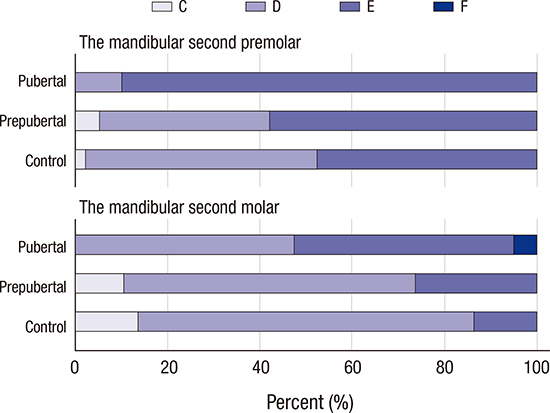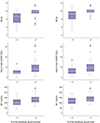1. Lee PA. Central precocious puberty. An overview of diagnosis, treatment, and outcome. [xi.]. Endocrinol Metab Clin North Am. 1999; 28:901–918.
2. Carel JC, Léger J. Clinical practice. Precocious puberty. N Engl J Med. 2008; 358:2366–2377.
3. Brauner R, Adan L, Malandry F, Zantleifer D. Adult height in girls with idiopathic true precocious puberty. J Clin Endocrinol Metab. 1994; 79:415–420.
4. Mrug S, Elliott M, Gilliland MJ, Grunbaum JA, Tortolero SR, Cuccaro P, Schuster M. Positive parenting and early puberty in girls: protective effects against aggressive behavior. Arch Pediatr Adolesc Med. 2008; 162:781–786.
5. Lee PA. Laboratory monitoring of children with precocious puberty. Arch Pediatr Adolesc Med. 1994; 148:369–376.
6. Brito VN, Batista MC, Borges MF, Latronico AC, Kohek MB, Thirone AC, Jorge BH, Arnhold IJ, Mendonca BB. Diagnostic value of fluorometric assays in the evaluation of precocious puberty. J Clin Endocrinol Metab. 1999; 84:3539–3544.
7. Resende EA, Lara BH, Reis JD, Ferreira BP, Pereira GA, Borges MF. Assessment of basal and gonadotropin-releasing hormone-stimulated gonadotropins by immunochemiluminometric and immunofluorometric assays in normal children. J Clin Endocrinol Metab. 2007; 92:1424–1429.
8. Lee DS, Ryoo NY, Lee SH, Kim S, Kim JH. Basal luteinizing hormone and follicular stimulating hormone: is it sufficient for the diagnosis of precocious puberty in girls? Ann Pediatr Endocrinol Metab. 2013; 18:196–201.
9. Nam HK, Rhie YJ, Son CS, Park SH, Lee KH. Factors to predict positive results of gonadotropin releasing hormone stimulation test in girls with suspected precocious puberty. J Korean Med Sci. 2012; 27:194–199.
10. Greulich WW, Pyle SI. Radiographic Atlas of Skeletal Development of the Hand and Wrist. 2nd ed. Stanford, CA: Stanford University Press;1959.
11. Tanner JM. Assessment of Skeletal Maturity and Prediction of Adult Height (TW3 Method). 3rd ed. London: W.B. Saunders;2001.
12. Martin DD, Wit JM, Hochberg Z, van Rijn RR, Fricke O, Werther G, Cameron N, Hertel T, Wudy SA, Butler G, et al. The use of bone age in clinical practice - part 2. Horm Res Paediatr. 2011; 76:10–16.
13. Demirjian A, Goldstein H, Tanner JM. A new system of dental age assessment. Hum Biol. 1973; 45:211–227.
14. Morris JM, Park JH. Correlation of dental maturity with skeletal maturity from radiographic assessment: a review. J Clin Pediatr Dent. 2012; 36:309–314.
15. Lewis JM, Senn DR. Dental age estimation utilizing third molar development: a review of principles, methods, and population studies used in the United States. Forensic Sci Int. 2010; 201:79–83.
16. Cho SM, Hwang CJ. Skeletal maturation evaluation using mandibular third molar development in adolescents. Korean J Orthod. 2009; 39:120–129.
17. Perinetti G, Contardo L, Gabrieli P, Baccetti T, Di Lenarda R. Diagnostic performance of dental maturity for identification of skeletal maturation phase. Eur J Orthod. 2012; 34:487–492.
18. Kumar S, Singla A, Sharma R, Virdi MS, Anupam A, Mittal B. Skeletal maturation evaluation using mandibular second molar calcification stages. Angle Orthod. 2012; 82:501–506.
19. Lehtinen A, Oksa T, Helenius H, Rönning O. Advanced dental maturity in children with juvenile rheumatoid arthritis. Eur J Oral Sci. 2000; 108:184–188.
20. Gaethofs M, Verdonck A, Carels C, de Zegher F. Delayed dental age in boys with constitutionally delayed puberty. Eur J Orthod. 1999; 21:711–715.
21. Roberts MW, Li SH, Comite F, Hench KD, Pescovitz OH, Cutler GB Jr, Loriaux DL. Dental development in precocious puberty. J Dent Res. 1985; 64:1084–1086.
22. Moon JS, Lee SY, Nam CM, Choi JM, Choe BK, Seo JW, Oh K, Jang MJ, Hwang SS, Yoo MH, et al. 2007 Korean national growth charts: review of developmental process and an outlook. Korean J Pediatr. 2008; 51:1–25.
23. Almeida MS, Pontual AA, Beltrão RT, Beltrão RV, Pontual ML. The chronology of second molar development in Brazilians and its application to forensic age estimation. Imaging Sci Dent. 2013; 43:1–6.
24. Landis JR, Koch GG. The measurement of observer agreement for categorical data. Biometrics. 1977; 33:159–174.
25. Maber M, Liversidge HM, Hector MP. Accuracy of age estimation of radiographic methods using developing teeth. Forensic Sci Int. 2006; 159:Suppl 1. S68–73.
26. Costacurta M, Sicuro L, Di Renzo L, Condò R, De Lorenzo A, Docimo R. Childhood obesity and skeletal-dental maturity. Eur J Paediatr Dent. 2012; 13:128–132.
27. Goyal S, Goyal S, Gugnani N. Assessment of skeletal maturation using mandibular second molar maturation stages. J Clin Pediatr Dent. 2014; 39:79–84.
28. Choi JW. Assessment of panoramic radiography as a national oral examination tool: review of the literature. Imaging Sci Dent. 2011; 41:1–6.
29. Ludlow JB, Davies-Ludlow LE, White SC. Patient risk related to common dental radiographic examinations: the impact of 2007 International Commission on Radiological Protection recommendations regarding dose calculation. J Am Dent Assoc. 2008; 139:1237–1243.
30. Kim EK. Effective dose of cone-beam computed tomography for orthodontic analysis in pediatric patient. J Korean Diet Assoc. 2015; 53:558–568.
31. Lee HS, Kim YJ, Shim YS, Jeong HR, Kwon E, Hwang JS. Associations between serum vitamin D levels and precocious puberty in girls. Ann Pediatr Endocrinol Metab. 2014; 19:91–95.
32. Houk CP, Kunselman AR, Lee PA. Adequacy of a single unstimulated luteinizing hormone level to diagnose central precocious puberty in girls. Pediatrics. 2009; 123:e1059–63.
33. Chaillet N, Nyström M, Demirjian A. Comparison of dental maturity in children of different ethnic origins: international maturity curves for clinicians. J Forensic Sci. 2005; 50:1164–1174.
34. Panchbhai AS. Dental radiographic indicators, a key to age estimation. Dentomaxillofac Radiol. 2011; 40:199–212.









 PDF
PDF ePub
ePub Citation
Citation Print
Print





 XML Download
XML Download